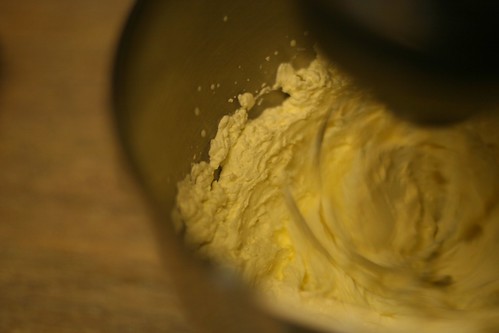
I know, I think I’m about the 400th blogger you’ve seen writing about making butter, but it is such a simple and amazing process, you really do have to try it. At least once. For me, attempting to make butter was not an economical decision (it’s hardly cheaper to make it yourself if you have to buy store bought cream) but it was just something I wanted to try. I wanted to watch the magical transformation of cream into butter because I’d never seen it before. How does a liquid turn into a solid, just by mixing? My dad grew up on a farm in southern Fremont and he remembers not only drinking raw milk, but joining in with his three other siblings to churn butter.
Being that I don’t have an old fashioned butter churn, but I do have my beloved KitchenAid, I gave it a shot. The key here, I think, is to let your cream come up to room temperature before you start mixing. Otherwise your poor mixer might blow a fuse from mixing SO long (as I worried mine might have done). But basically that is it. Just put on your whisk attachment, pour in the cream, turn it on and watch. I like a little salt in my butter so I did add an unmeasured amount of salt.
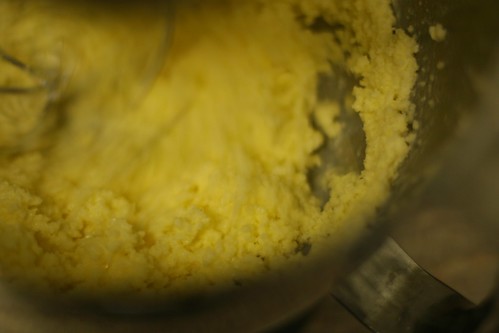
We’ve made whipped cream countless times, but we’ve never ventured further than that before, so I was curious. It stayed in a whipped cream like state for a good while, but soon I noticed that it was getting slightly clumpier and yellow looking.
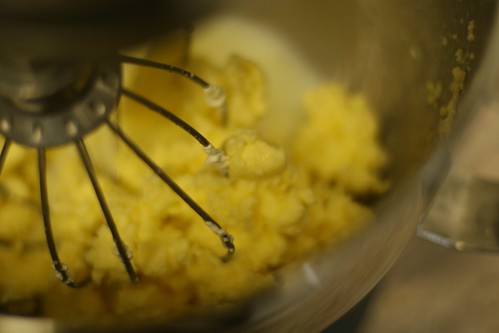

Then I noticed a small amount of milky liquid in the bowl at which point almost immediately the whole thing separated out, yellow butter and liquid. It was quite fascinating to watch! The butter clung to the whisk, so I stopped it. Took it off and put the butter into a strainer and rinsed it with water while smooshing it around. Then I placed it into a plastic wrapped lined tupperware that was approximately the length of a standard stick of butter and refrigerated it.
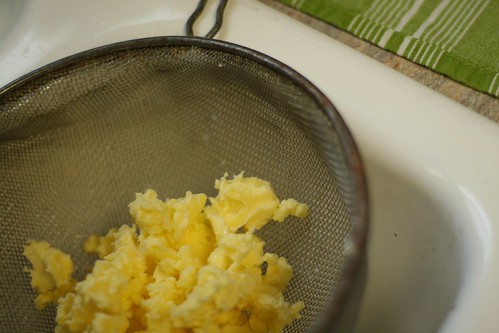
I sliced it in half, lengthwise and put it into our regular butter dish. We did a taste test, my butter against Danish Creamery butter. Danish Creamery is much saltier and less creamy than my homemade version. Despite it’s good taste, I don’t know if butter making will become a regular event in our house. I suppose if I had a good source of fresh, inexpensive, raw milk here it would. But it is a great fun thing to try from time to time. And of course goes even better with marmalade.

Have you tried making butter yet? How did it go? Do you have a source for local raw milk?

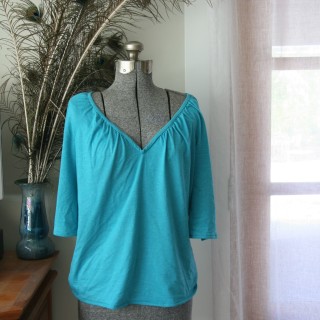
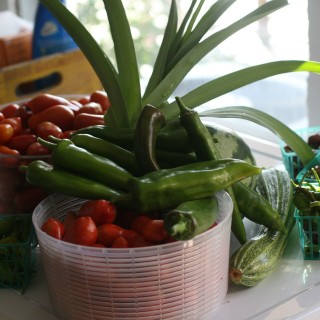
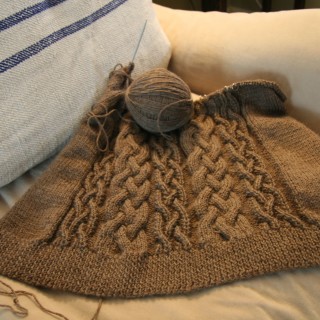
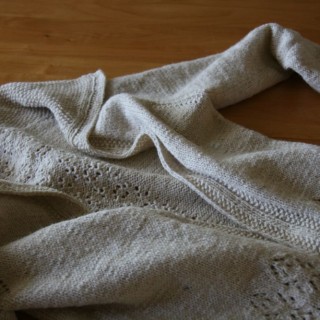

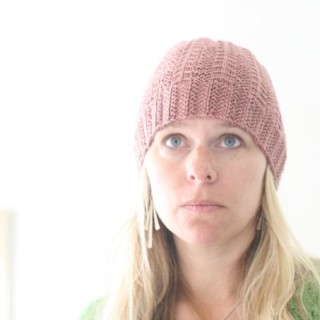

We get raw milk from a local farm and we make butter each week. It is cheaper for us since we have the cream already. I use a half gallon canning jar to make my butter (always looking for ways to save on electric). I also like to culture my cream a bit, sometimes I simply let it sour at room temp (raw milk has natural enzymes so it doesn’t spoil) and sometimes I culture with some yogurt. Cultured butter is kind of like a cross between cream cheese & butter – delicous!
I blogged about making butter a while ago: http://chiotsrun.com/2010/01/06/make-your-own-butter/
You actually want to make sure your cream is around 60 (in case you keep your house warmer). If you let the cream get too warm it’s difficult to rinse the cream because you end up with kind of a whipped butter. If you try to use to cold of cream you’ll churn all day and never end up with anything. I find that at 60 the cream turns to butter in about 10 mins of churning by hand.
I’ve got to try this. Localharvest.org will probably hook you up with a local source for raw milk.
Thanks!
we’ve made butter and blogged about it too…loved it but also not an everyday occurrence.
If I had a cow or goat, it sounds like a great idea. Purchasing it. . . well, we eat a lot of butter.
But I promise not to blog about it if we do it again.
Over the years I have made butter many times, mostly to amaze small children, Brownies, 1st graders, etc. I have found that it pays to check on the butterfat content of any heavy cream one buys. There is a difference; the higher the butterfat content the more butter (obviously). The higher the butterfat the easier it will be to whip, also.
Where I live (Sonoma County) the two highest in butterfat would be Trader Joe’s and Clover. There were others, but they have since gone out of business. If you can’t tell what you have call the dearest dairy and ask where to find “manufacturers cream”. Terrible sounding name but it is what restaurants etc use for whipped cream. It will have a very high butterfat content. You will probably have to buy it by the quart, but if you are making butter, you might as well.
Making butter is a lot of fun, and kids should be aware of how it happens, but it is not an economical endevour unles you have cow or other source for the cream.
Great post!!! Thanks for sharing your butter making experience… I too have made it this way and so long for a dairy cow of my very own so that I can have a constant supply of fresh milk..
Take Care…
We saved the buttermilk that seperated from the butter and used that too a couple days later to make pancakes with. Pancakes with home made butter that is. Soooo good. I’ve not used raw milk though. That will be the next trial. Thank you.
I’m cracking up over here – b/c I bought some cream the other day just for this purpose! I haven’t done it yet, was planning on doing it tomorrow. Too funny
We make homemade butter every week with fresh cows milk; don’t throw out the “clear liquid” that is left after the butter separates. You can use that as is or let it get thicker; it is BUTTERMILK. This makes the best pancakes, waffles, biscuits, or bread. It is very acidic and causes you baked goods to rise better. I usually make a large batch of “Rumford Pancakes” and freeze the extras to have on hand for my four kids at breakfast. If I get tired of too many pancakes on hand, I’ll make buttermilk bread the next week and freeze one loaf. The first time I made homemade butter, I wasn’t sure what that liquid was and just threw it down the sink. I still feel bad about that now, since it is so great in baked goods.
We are fortnuate in Sonoma County to have so many rich resources at our fingertips – A Sonoma Garden and their wonderful “How To’s” as well as local farms that supply goods like raw milk.
Check out this article on a local Sonoma County family who sells “cow shares” as means to obtain inexpensive, high quality raw milk. We love Dasi and Buttercup’s milk and you will too!
http://sono-ma.blogspot.com/2010/01/exploring-benefits-of-family-cow-and.html
Thanks!
Yes, I did – I made mine with the cream I ladled off non-homogenized milk myself. I then cultured the cream with piima culture. The results were not to be believed.
http://richfoodleantimes.wordpress.com/2010/04/24/alice-in-dairyland-ii/
It’s even better if you culture it first, as Sofya suggested. You can follow the same process that you would to make yogurt or sour cream using cream instead of milk, then process in the food processor. I will never eat uncultered butter again.